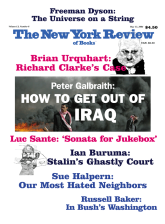To the Editors:
In a recent letter [NYR, October 9, 2003], Professor Mordechai Feingold took issue with Freeman Dyson’s view that Isaac Newton had a part in the formation of civil liberties in England. But evidence supports Professor Dyson’s statement. In 1687 Newton dedicated himself to assisting the nationwide resistance against James II that led to the Glorious Revolution in 1688 and the writing of the Bill of Rights in 1689. As part of a delegation from Cambridge University, Newton appeared before James II’s Ecclesiastical Commission to protest a royal mandate requiring Trinity College to admit a Catholic Master of Arts. It was understood that the mandate would open the way to Catholic domination of university policy. Newton then presumably hired a scrivener to transcribe documents justifying resistance in a similar case at Magdalen College, Oxford. The manuscript I discovered in the Magdalen archives (MS 432) records royal proceedings against Magdalen College, and it shows clearly that James II’s public policy toward it violated his own code of law. Newton obviously used this document to build the Cambridge case against the crown.
MS 432 bears the watermark of the original manuscripts in Newton’s possession when he left them among his writings at Trinity College in 1696. In this sense it is an authentic Newton manuscript, attested to by the Magdalen College librarian, with papers providing evidence for its authenticity at the Bodleian at Oxford and at Trinity, King’s College, and the University Library at Cambridge. Although some experts have thought MS 432 is in Newton’s hand, I disagree and never alleged that it was “by Newton.” It simply confirms his intention to protect what we now call civil liberties.
An admiring Locke read the Principia in exile in Holland. When he met Newton in England in 1689 they became friends and collaborators. Locke’s obsession with anonymity blurs the textual history of prepublication for the Two Treatises of Government, first printed in 1689. Certainly it was common at the time to revise up until the last moment before printing; four months of friendship gave Locke ample time to verify Newton’s vision of political reality. Furthermore, the internal evidence of relevant documents indicates that Locke clearly understood Newton’s concept of natural rights based on axiomatic, self-evident laws governing both mathematical and moral reasoning. These considerations suggest that Newton’s work did influence the Two Treatises.
For Newton and Locke the physical and moral universe flowed from a divine cause unifying truths as self-evident as the beauty of Euclidean space. Their philosophy powerfully shaped the history of natural rights.
Sarah Jones Nelson
Princeton, New Jersey
This Issue
May 13, 2004



